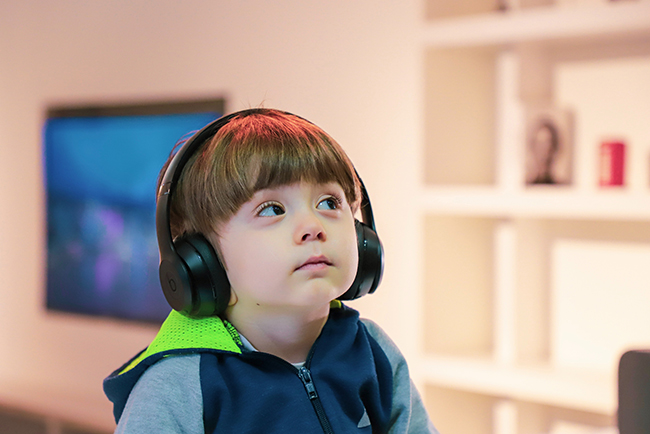
How can churches take steps to help kids with disabilities feel more comfortable in our worship services? Here are a few ideas.
By Sandra Peoples
Lighting that’s too dark or too bright, lots of people coming in at the same time to find seats (many of them shaking hands or hugging), and music and voices from the stage can all be overwhelming to kids with sensory sensitivities and disabilities such as autism.
Week after week we noticed our son would cover his ears, avoid talking or bumping into people, and last only a few minutes before he needed to leave the worship service. It was all too much for him to feel comfortable. The same is true for many children and teens in our churches. But we know their presence is important to our church families. Paul tells the church in Corinth that all parts are necessary for the church body to be healthy:
As it is, there are many parts, but one body. The eye cannot say to the hand, ‘I don’t need you!’ Or again, the head can’t say to the feet, ‘I don’t need you!’ On the contrary, those parts of the body that are weaker are indispensable. And those parts of the body that we consider less honorable, we clothe these with greater honor, and our unrespectable parts are treated with greater respect, which our respectable parts do not need.
1 Corinthians 12:20-24a (CSB)
So how can we take steps to help those with sensory sensitivities and autism feel more comfortable in our worship services? We’ve taken steps that I hope will be helpful for you as well.
1. Give students opportunities to acclimate to the worship service setting when it’s less overwhelming
We invite students to come to the church on Wednesday nights to take steps to feel more comfortable. First, they can sit in the empty worship center to get used to the room and lighting. To help increase the time they are able to sit in the worship center, you can use a visual timer, a visual schedule, or sensory items such as fidgets.
Second, they can attend worship team practice so they know what to expect with the sound levels and get used to the worship space with some people in it (but not as many as during a service). After a few weeks, they feel more comfortable and can join the congregation for the service on Sunday mornings. Our son now joins his church family for the music at the beginning of the service. Then his class goes to their classroom during the sermon for a Bible story and activities that meet their level of needs.
2. Offer buddy bags and noise-reducing headphones in the lobby
Not everyone with sensory sensitivities and autism needs to take the steps our son did to feel comfortable. Some of them just need a few tools to be successful. So, we offer drawstring backpacks we call “buddy bags” with a tag that says, “Sensory overload? Feeling fidgety? Please help yourself to this sensory bag.” In the bag, we have fidgets, coloring sheets, crayons, a fruit snack, and noise-reducing headphones.
Offering tools to help kids who experience sensory overload allows churches to communicate to special needs families that they are welcome at our church and we’re willing to take steps to meet their needs. Click To TweetIf the person doesn’t need the whole bag, we also have noise-reducing headphones hanging near the bags so they can grab a pair on the way in. There’s a basket where they can return all the items so we can clean them and get them ready for the next service. This display allows us to communicate to special needs families that they are welcome at our church and we’re willing to take steps to meet their needs.
3. Help church members understand the opportunities they have to show grace and support
If having members with sensory sensitivities and autism is new for your church, it’s helpful to let long-time members know what to expect and how to react in situations they may not have experience with. The pastoral team can communicate ways to be helpful through emails and social media posts like this: “Our church welcomes people with autism and other disabilities who can have a hard time processing sensory input like lights and sounds. To help, we have noise-reducing headphones and other tools available in the lobby. You can also help make their families feel welcome in the service by understanding their reactions may be expressed through noises and repetitive movements. Let’s show these families how much we value their presence by smiling and being supportive.” Creating an atmosphere of hospitality and belonging will benefit everyone.
“Creating an atmosphere of hospitality and belonging will benefit everyone.” — @SandraPeoples Click To TweetTaking these steps can help children and teens feel welcome and comfortable in your worship service. In Jesus’s last week on earth, He cleansed the temple of the money changers who were likely set up in the area where those with disabilities had access to enter. Matthew 21:14a says after He drove them out, “the blind and the lame came to him in the temple” (CSB). We can follow His example today by making room and accommodations for people with autism and sensory sensitivities so they can experience the hope of the gospel and the hospitality of a church family. All it takes is a few extra steps to accommodate our indispensable members.

Sandra Peoples
Sandra (M Div, PhD student) is the disability ministry consultant for the Southern Baptists of Texas Convention, an adjunct instructor for Liberty University, and the author of Unexpected Blessings: The Joys and Possibilities of Life in a Special-Needs Family. She and her family live outside of Houston, TX.












